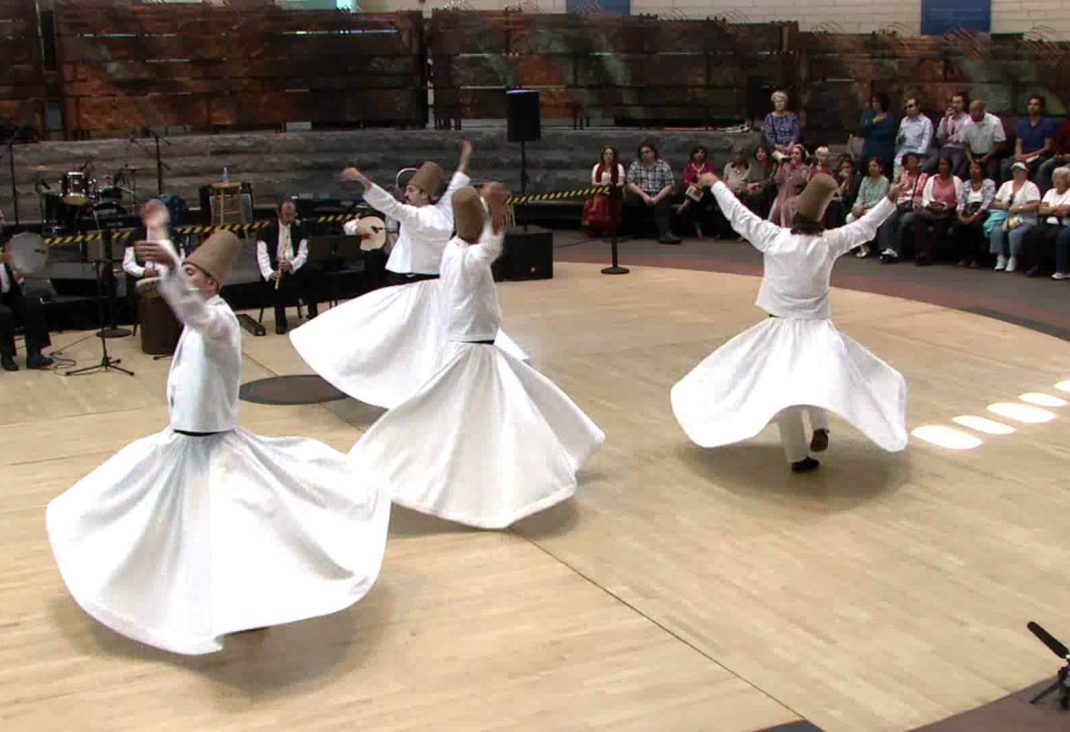SUFISM
Sufism, the mystical Islamic practice in which Muslims seek divine love and knowledge through a direct personal experience with God, has been vitally important in the development of Islam. Islam spread to Turkey thanks to the efforts of traveling Sufi dervishes, who also established the religion in Central Asia, India, and Sub-Saharan Africa. Sufism began in opposition to the material excess of the Umayyad caliphate (661-750), and it sought to refocus the Islamic community on the spiritual goals of Islam. Guided by the Sufi master, the murid (disciple) achieves the tariqa (path) of Sufism through a strict regimen of ascetic practices. Sufis believe that self-denial, through acts like fasting, permits victory’ over the ego, the elimination of all thoughts of self in the quest for fan-fi-Allah (annihilation in God). Emphasizing universal love between God and humans, Sufi followers are a tolerant and peaceful people, marked by compassion and humility.
Although the Sufis were outside the mainstream of orthodox Islam and some of their more esoteric practices were never far from heresy, the orders enjoyed great privileges in the Ottoman Empire. Under the Ottomans, the Sufi orders lived in lodges that were endowed by the state, rich patrons, and charity. Under Atatürk’s 1925 secular reforms, all ceremonies, meetings, and costumes associated with the Sufi orders were officially banned. But the government was unable to suppress such an established religious tradition, and Turkey has witnessed the gradual reemergence of Sufi customs and practice. The English language cannot always adequately translate terms describing Sufism, so consider words like “mystic” and “order” to be approximations.
MEVLEVi ORDER
Since in order to speak, one must first listen, learn to speak by listening. -Celeddin-i-Rumi
The Mevlevi order was founded in Konya in the late 13th century by the Persian mystic and poet Celeddin-i Rumi , whose popular title, Mevlâna (our master), gave the order its name. Known to the West as the Whirling Dervishes because of their ritual dance ceremony, the disciples of the order lived in tekke, which included living quarters, a prayer room, a kitchen, and a galleried semahane (dance hall). The Mevlevi’s ritual whirl, or sema, is a spiritual exercise that allowed disciples to attain a state of union with God. The dancers’ tall camel-hair hats represent tombstones, the black cloaks signify tombs, and the white robes a death shroud. In casting off the black cloaks, the dancers set aside all worldly ties and step out of the tomb of the self. Their arms extended the right palm facing the heavens, the left facing the ground the dervishes whirl slowly, channeling the mystical energy’ that makes the world turn.
The Mevlevi impact on poetry, calligraphy, and the visual arts from the 14th to 20th century is profound. Perhaps an even more important contribution to Ottoman culture is their development of a religious music, as music was frowned upon by Orthodox Islam. In 1954, the Turkish government allowed the Mevlevi ritual dance (sema) to be performed for tourists during the week preceding the anniversary of Rumi’s death on December 17. Since then, the Mevlevi have gained more freedom to display their dance, and sema can be seen almost every other week at Hie Galat Mevlihane in Istanbul. Today the Mevlâna’s türbe (tomb) in Konya, officially a museum, attracts the faithful.
BEKTAŞİ ORDER
We have recognized the unity of Allah… We have been the intoxicated ones from all eternity-we are butterflies in the divine light. -Jevad Paşa
The Bektaşi order of Sufism was founded by Haci Bektaş Veli, who was born around 1248 in Iran. Haci Bektaş came to Anatolia in the late 13th century and lived in Kayseri, Kirşehir, and Sivas before founding his monastic complex in Suluca Karahöyük, where he died in 1337. His teachings helped popularize Islam in pre-Ottoman Anatolia, finding a particular resonance among soldiers and peasants. Haci Bektaş espoused a folksy brand of Sufism characterized by maxims like “seek and you shall find.” His bestselling self-help book Makalat touted the “Four Doors,” or steps to enlightenment.
The Bektaşi, originally Sunni, began to assimilate Shi’ite practices in the 16th century. This explains the close ties between the Bektaşi and Shi’ite Alevi communities. The white-capped Bektaşi were famous for their slightly unorthodox behavior, including ritual wine swilling, dancing, and Christian practices such as bread sharing and the confession of sins. They rose from a rural base to political importance in the 15th century, when their order began to dominate the elite Janissary Ottoman military corps. Bektaşi influence waned after 1826, however, when the “Auspicious Event” (see The 19th Century: Reform and Reaction, eliminated the Janissary corps. Today, at an annual middle August gathering, thousands still gather in Hacibektaş to commemorate its namesake with dancing.



Leave a Reply